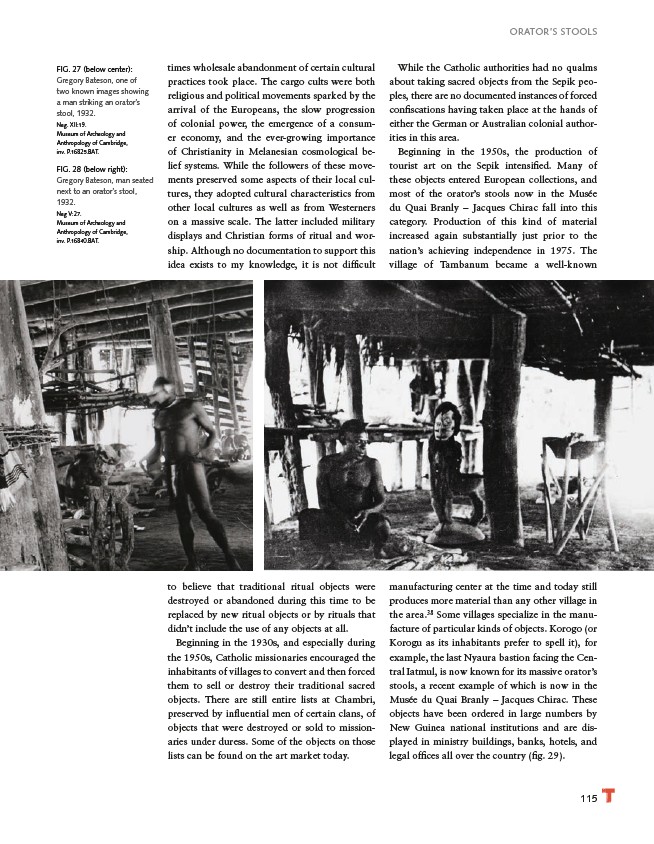
ORATOR’S STOOLS
115
FIG. 27 (below center):
Gregory Bateson, one of
two known images showing
a man striking an orator’s
stool, 1932.
Neg. XII:19.
Museum of Archeology and
Anthropology of Cambridge,
inv. P.16825.BAT.
FIG. 28 (below right):
Gregory Bateson, man seated
next to an orator’s stool,
1932.
Neg V:27.
Museum of Archeology and
Anthropology of Cambridge,
inv. P.16840.BAT.
times wholesale abandonment of certain cultural
practices took place. The cargo cults were both
religious and political movements sparked by the
arrival of the Europeans, the slow progression
of colonial power, the emergence of a consumer
economy, and the ever-growing importance
of Christianity in Melanesian cosmological belief
systems. While the followers of these movements
preserved some aspects of their local cultures,
they adopted cultural characteristics from
other local cultures as well as from Westerners
on a massive scale. The latter included military
displays and Christian forms of ritual and worship.
Although no documentation to support this
idea exists to my knowledge, it is not difficult
to believe that traditional ritual objects were
destroyed or abandoned during this time to be
replaced by new ritual objects or by rituals that
didn’t include the use of any objects at all.
Beginning in the 1930s, and especially during
the 1950s, Catholic missionaries encouraged the
inhabitants of villages to convert and then forced
them to sell or destroy their traditional sacred
objects. There are still entire lists at Chambri,
preserved by influential men of certain clans, of
objects that were destroyed or sold to missionaries
under duress. Some of the objects on those
lists can be found on the art market today.
While the Catholic authorities had no qualms
about taking sacred objects from the Sepik peoples,
there are no documented instances of forced
confiscations having taken place at the hands of
either the German or Australian colonial authorities
in this area.
Beginning in the 1950s, the production of
tourist art on the Sepik intensified. Many of
these objects entered European collections, and
most of the orator’s stools now in the Musée
du Quai Branly – Jacques Chirac fall into this
category. Production of this kind of material
increased again substantially just prior to the
nation’s achieving independence in 1975. The
village of Tambanum became a well-known
manufacturing center at the time and today still
produces more material than any other village in
the area.38 Some villages specialize in the manufacture
of particular kinds of objects. Korogo (or
Korogu as its inhabitants prefer to spell it), for
example, the last Nyaura bastion facing the Central
Iatmul, is now known for its massive orator’s
stools, a recent example of which is now in the
Musée du Quai Branly – Jacques Chirac. These
objects have been ordered in large numbers by
New Guinea national institutions and are displayed
in ministry buildings, banks, hotels, and
legal offices all over the country (fig. 29).